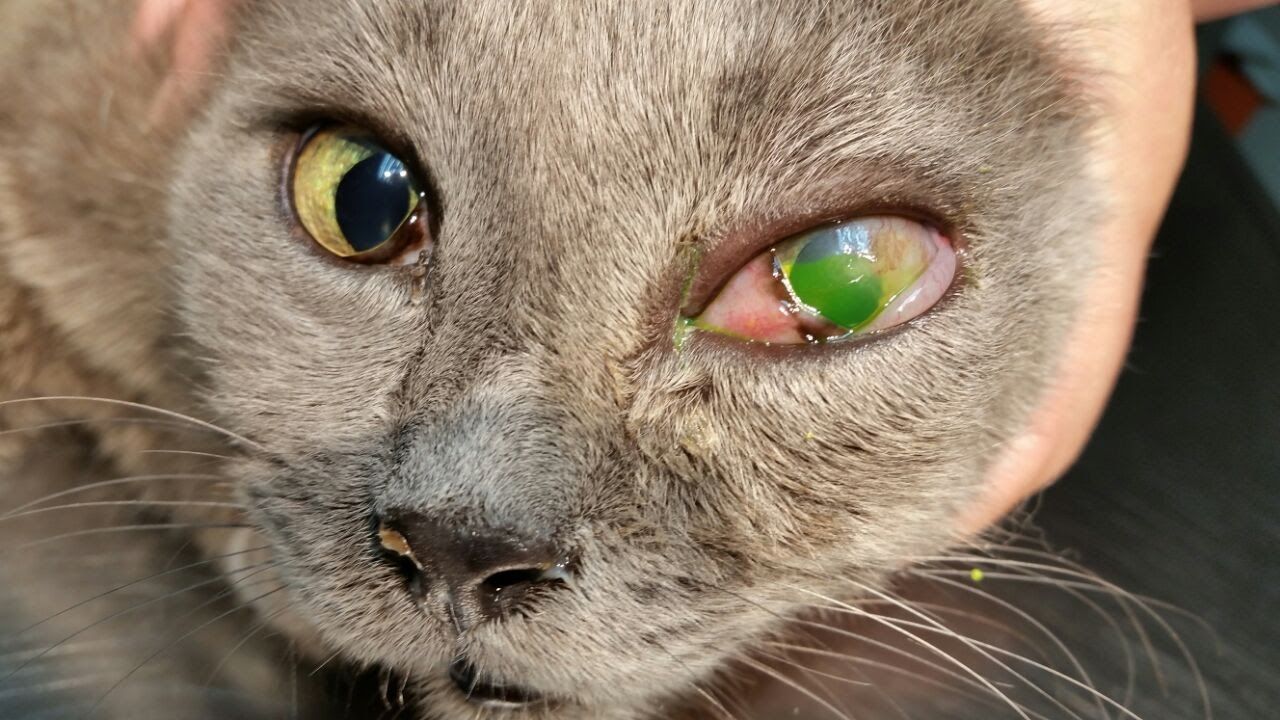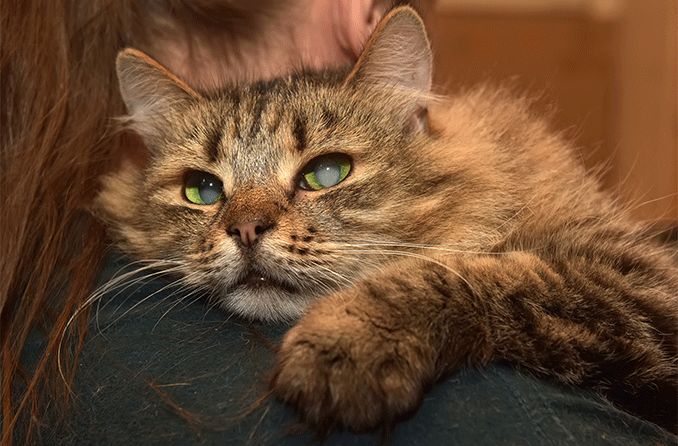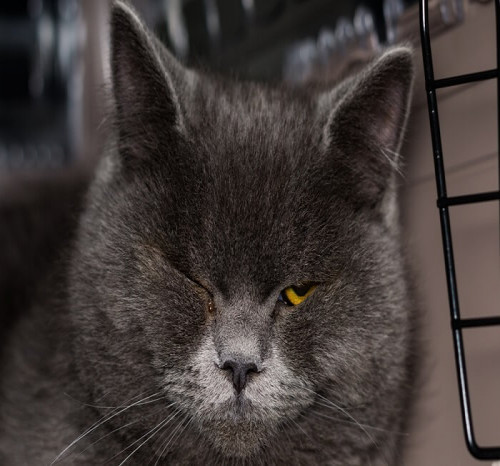Introduction
Keep an eye out for signs of vision impairments in cats. When it comes to hunting and stalking prey, cats rely almost exclusively on their eyesight, in contrast to dogs who employ a combination of sight, hearing, and scent to learn their environment. It may be painful, as evidenced by the person’s watery eyes, frequent blinking, squinting, and pawing at their eyes. The nictitating membrane is an additional eyelid found only in cats. Most likely, something is amiss if this second eyelid is noticeable.
1. Conjunctivitis

The inflammation of the conjunctiva is medically referred to as conjunctivitis. Like the lining of the mouth and nose, the conjunctiva is a mucous membrane. This mucus-secreting epithelial cell membrane lines the eyelids and covers the eyeball. On the inner corner of a cat’s eye is a third eyelid called the nictitating membrane, which is covered by conjunctiva. The conjunctiva of a healthy cat’s eyelids is a faint pink and not easily apparent. The conjunctival membranes grow red and puffy when conjunctivitis strikes. One or both eyes may be affected by conjunctivitis.
Symptoms
Redness and swelling of the conjunctiva, as well as possible watering and discharge from the eye, are all symptoms of inflammation. Infectious conjunctivitis in cats is brought on by viruses or bacteria, while non-infectious conjunctivitis occurs when something irritates the eye but does not spread the disease. Inflammation can develop in either one or both eyes.
Treatment
The veterinarian may tell you to wait it out if you take your cat in with conjunctivitis because the condition may clear up without any treatment. Antibiotic eye drops can treat conjunctivitis, but your vet may recommend further therapy for the underlying cause of the condition. A frequent method of treating conjunctivitis in cats is using antibiotic ointments applied topically. To combat bacterial infections of the eyes, ointments are the standard treatment.
2. Uveitis
Any inflammation of the uveal structures is known as uveitis. Anterior uveitis refers to inflammation of the ciliary body and iris, while posterior uveitis refers to inflammation of the choroid alone. If inflammation affects all three structures, the illness is known as panuveitis or genuine uveitis. Uveitis can affect either eye individually or both eyes simultaneously.
Symptoms
The beginning of uveitis in cats can be either acute and abrupt, or chronic and difficult to diagnose until it has progressed significantly. As uveitis can lead to blindness, it’s possible that the only symptom you’ll notice is the sudden disappearance of your cat, as the sight of blood in their eyes would be terrifying. Affected eyes can be one or both of your cats. The typical red eye is really noticeable. Your cat may squint, appear to be sensitive to light, and have a runny eye.
Treatment
Treatment for uveitis commonly involves topical eye treatments such as corticosteroids and non-steroidal anti-inflammatory agents to reduce inflammation and alleviate pain. In some cases, antiviral drugs may be used, and antibiotics may be required to manage any secondary infections that develop. The specific course of treatment for uveitis will depend on the etiology of the condition. Because uveitis is so challenging to cure, your cat will need to be seen by the vet regularly to monitor its progress.
3. Cataracts

Eye lenses are affected by cataracts. The lens focuses light entering the eye, allowing your cat to see. If a cataract clouds this little structure, it cannot focus light, blurring eyesight. Proteins and water compose the lens. Protein and fiber modifications cloud the lens. Cataracts are rarer in cats than in humans and dogs. Diabetes can cause cataracts in humans and dogs, but cats rarely do. They’re particularly common in older cats.
Symptoms
If your cat is vocalizing more at night or missing jumps, it may indicate a visual loss. When the light is right, you may perceive a cloudiness or dark area in the central eye. Ultimately, ocular problems can produce cataracts. Redness, squinting, excessive crying, green or yellow discharge from the eye, bulging of the eye, or a raised third eyelid are all indicators that your cat needs to see a vet.
Treatment
Cataract surgery is the standard and best option for feline cataract treatment. A surgeon will use a microscope to make extremely precise cuts. Often, the cornea and lens capsule are the target areas for the incisions. Once an incision has been made, the surgeon will insert a special tool that emits high-frequency sound to shatter the cataract. They will dissolve the lens, take it out, and replace it with a prosthetic. After the incisions are closed, your cat ought to recover well.
4. Corneal Ulcers

The transparent membrane covers and shields the cornea at the front of the eye. It consists of three distinct layers, each of which is see-through. An ulcer forms in the cornea when one of these layers sustains structural damage, like a tear or scrape. It’s also known as an erosion or abrasion of the cornea. Cats’ corneal ulcers can range from mild to quite serious depending on their depth and severity.
Symptoms
Extreme discomfort is felt as a corneal ulcer develops. Most cats will rub their damaged eye against hard surfaces like the carpet or furniture to alleviate the excruciating pain. To avoid damage, they may squint, blink fast, or close their eyelids completely. From time to time, a discharge may accumulate in the crease of the eyelid or trickle down the side of the face.
Treatment
Antibiotics are typically administered for cases of superficial corneal ulcers. They help reduce the cat’s discomfort, prevent further damage to the diseased eye, and relax the ciliary muscles. Corneal suturing, corneal transplant, conjunctival flaps and grafts, and contact lenses are among the more invasive treatments that may be necessary if your cat has corneal ulcers that extend deeper than the stromal layer. Through surgical therapy, the cornea can be stabilized and its natural functions restored, including eyesight.
5. Glaucoma

While your cat’s eyes are healthy, a constant flow of fluid from the inside out serves to regulate the pressure inside. Glaucoma is the result of a blockage in the drainage system of your cat’s eye, which leads to an increase in pressure within the eye. Damage to the retina and optic disc, where the optic nerve enters the eye, can result from a cat’s eye experiencing greater pressure.
Symptoms
Although glaucoma is brutally unpleasant, cats are particularly adept at disguising their symptoms. Hiding decreased affection and decreased grooming are all subtle yet telltale symptoms of disease or pain. Cats with glaucoma may also show other symptoms such as one eye being closed, the cat pawing at its eye, a watery discharge, visible enlargement or bulging of the eyeball, redness, cloudiness, a dilated pupil, or even total blindness.
Treatment
Open the drain to treat glaucoma, which arises when fluid doesn’t drain rapidly enough. Sadly, opening and maintaining the drain is hard. Hence, several glaucoma treatments reduce eye fluid production. Many pricey eye treatments and medications reduce fluid production or improve fluid drainage. Glaucoma surgery depends on the eye’s vision potential. A drainage implant and cycloablation treatment can lower intraocular pressure in seeing eyes. Eyes can be enucleated for permanent blindness.
6. Entropion

Entropion is eyelid margins turning inward. It rarely affects cats’ lower eyelids. Due to other eye abnormalities, cats develop entropion later in life. Eyelid spasms from corneal damage or untreated conjunctivitis are the most common cause. Unlocking this problem in adult cats with herpes virus infections.
Enophthalmos or shrinkage can cause subsequent entropion. Eyelid neuropathy can cause entropion.
Symptoms
One or both eyes may be affected by entropion, and if only one eye is affected, the symptoms may be different. There are various diseases that can cause these symptoms in cats, so it’s crucial to get your pet checked out by a vet as soon as you see anything unusual. Sunken eyes, squinting, etc. Signs include a drooping third eyelid and pawing at the affected eye.
Treatment
The majority of cases of feline entropion require surgical intervention. Rolling out the eyelid necessitates removing a small, elliptical piece of skin from the inrolling region and stitching the wound closed. As to how much tissue should be removed, that is a question of clinical decision and experience.
Final Thoughts on Vision Impairments in Cats
Cats can develop serious eye problems, so if you see any of the symptoms listed below, it’s time to make an emergency trip to the vet. Due to the overlap in symptoms between different causes of eye diseases, a proper diagnosis can only be made through physical inspection. In the event that your cat’s eye ailment is significant, wasting time trying to diagnose the issue or hoping it would go away on its own is not an option.
hey we have a lot of information on cats you can check out by clicking Bristhorthair.com
wants to follow us on social media
Could it be said that a cat’s eyesight is adequate?
Cats’ vision is roughly 20/100 to 20/200, which indicates that although a human can see an object clearly from 100 feet away, the cat would have to be 20 feet away for the thing to seem sharp.
How to keep cat’s eyesight good?
Make sure to get your pet checked out by the vet often. Make sure your cat gets updated vaccines regularly. Always keep an eye out for any unusual behaviour in your cat’s eyes. Diabetes and high blood pressure are only two of the many underlying health conditions that can be treated to improve your cat’s overall quality of life.

